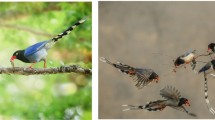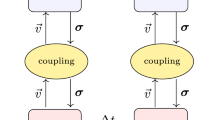Abstract
Robust optimization design is significant and urgently required for the fly wings, owing to its unique characteristics. However, there is a lack of efficient tools for performing shape optimization which considers multiple uncertainties. This is in part because implementing robust design in the widely used and very efficient adjoint-based optimization method is challenging. This paper addresses this need by developing an uncertainty-based optimization design framework where the gradient-enhanced polynomial chaos expansion and discrete, adjoint-based optimization framework are coupled to perform shape optimization under multiple uncertainties. The gradient information from adjoint equation is applied to improve the computation efficiency. The objective function is the statistic moment, consisting of mean and standard deviation. The gradients of the statistic moment are computed using the adjoint-based system and reconstructing a regression algorithm. A flying wing configuration with deterministic and two uncertainty-based optimizations is performed. The first uncertainty-based optimization considers flight conditions, Mach and angle of attack, and the second one added the planform uncertainty parameters, i.e., inner and outer wing sweep angle. The uncertainty-based optimizations gain reductions of statistic moments by 8.58% and 5.3%, respectively. Compared with the deterministic optimization, the uncertainty-based optimizations behave much better in robustness but sacrifice a small aerodynamic performance. The successful uncertainty-based optimization enables acceptable risks of fly wing design in the development process and indicates that our established framework can be applied for future aircraft robust optimization design.



















Similar content being viewed by others
References
Aubeelack H, Segonds S, Bes C, Druot T, Bérard A, Duffau M, Gallant G (2022) New methodology for robust-optimal design with acceptable risks: an application to blended/wing/body aircraft. AIAA J 60(5):3048–3059
Blatman G, Sudret B (2008) Sparse polynomial chaos expansions and adaptive stochastic finite elements using a regression approach. Comptes Rendus Mécanique 336(6):518–523
Guo L, Narayan A, Zhou T (2018) A gradient enhanced l1-minimization for sparse approximation ofpolynomial chaos expansions. J Comput Phys 367:49–64
Hascoët L (2004) Tapenade: A tool for automatic differentiation of programs. Proceedings of 4th European congress on computational methods. ECCOMAS, Jyvaskyla
He X, Li J, Mader CA, Yildirim A, Martins JRRA (2019) Robust aerodynamic shape optimization-from a circle to an airfoil. Aerosp Sci Technol 87:48–61
Hu X, Chen X, Parks GT, Yao W (2016) Review of improved Monte Carlo methods in uncertainty-based desig optimization for aerospace vehicles. Prog Aerosp Sci 86:20–27
Hwang JT, Jasa J, Martins JRRA (2019) High-fidelity design-allocation optimization of a commercial aircraft maximizing airline profit. J Aircr 56(3):1165–1178
Kenway GKW, Mader CA, He P, Martins JRRA (2019) Effective adjoint approaches for computational fluid dynamics. Prog Aerosp Sci 110
Knio OM, Le Maitre O (2006) Uncertainty propagation in cfd using polynomial chaos decomposition. Fluid Dyn Res 38(9):616
Kroo I (2004) Innovations in aeronautics. 42nd AIAA aerospace sciences meeting and exhibit. ARC, p 1
Kuntawala N, Hicken J, Zingg D (2011) Preliminary aerodynamic shape optimization of a blended-wing-body aircraft configuration. 49th AIAA aerospace sciences meeting including the new horizons forum and aerospace exposition. University of Toronto, p 642
Liebeck RH (2004) Design of the blended wing body subsonic transport. J Aircr 41(1):10–25
Luke E, Collins E, Blades E (2012) A fast mesh deformation method using explicit interpolation. J Comput Phys 231(2):586–601
Lyu Z, Martins JRRA (2014) Aerodynamic design optimization studies of a blended-wing-body aircraft. J Aircr 51(5):1604–1617
Mader CA, Martins JRRA (2013) Stability-constrained aerodynamic shape optimization of flying wings. J Aircr 50(5):1431–1449
Meheut M, Arntz A, Carrier G (2012) Aerodynamic shape optimizations of a blended wing body configuration for several wing planforms. 30th AIAA applied aerodynamics conference. ARC, p 3122
Menter FR (1994) Two-equation eddy-viscosity turbulence models for engineering applications. AIAA J 32(8):1598–1605
Mura R, Ghisu T, Shahpar S (2020) Least squares approximation-based polynomial chaos expansion for uncertainty quantification and robust optimization in aeronautics. AIAA AVIATION 2020 FORUM. ARC, p 3163
Najm HN (2009) Uncertainty quantification and polynomial chaos techniques in computational fluid dynamics. Ann Rev Fluid Mech 41:35–52
Padulo M, Campobasso MS, Guenov MD (2011) Novel uncertainty propagation method for robust aerodynamic design. AIAA J 49(3):530–543
Paiva RM, Crawford C, Suleman A (2014) Robust and reliability-based design optimization framework for wing design. AIAA J 52(4):711–724
Palar PS, Tsuchiya T, Parks G (2015) Decomposition-based evolutionary aerodynamic robust optimization with multi-fidelity point collocation non-intrusive polynomial chaos. 17th AIAA non-deterministic approaches conference. ARC, p 1377
Qin N, Vavalle A, Le Moigne A (2005) Spanwise lift distribution for blended wing body aircraft. J Aircr 42(2):356–365
Reist TA, Zingg DW (2013) Aerodynamic shape optimization of a blended-wing-body regional transport for a short range mission. 31st AIAA applied aerodynamics conference. ARC, p 2414
Sabater C, Bekemeyer P, Görtz S (2022) Robust design of transonic natural laminar flow wings under environmental and operational uncertainties. AIAA J 60(2):767–782
Sederberg TW, Parry SR (1986) Free-form deformation of solid geometric models. SIGGRAPH Comput. Graph. 20(4):151–160
Shankaran S, Jameson A (2011). Robust optimal control using polynomial chaos and adjoints for systems with uncertain inputs. In 20th AIAA computational fluid dynamics conference. p 3069
Spalart P, Allmaras S (1992) A one-equation turbulence model for aerodynamic flows. 30th aerospace sciences meeting and exhibit. AIAA
van der Weide E, Kalitzin G, Schluter J, Alonso JJ (2006) Unsteady turbomachinery computations using massively parallel platforms. Proceedings of the 44th AIAA aerospace sciences meeting and exhibit. AIAA
Wakayama SR, Kroo IM (1990) A method for lifting surface design using nonlinear optimization. AIAA Paper, p 3120
Wei C, Huang J, Song L (2022) Study on a rapid aerodynamic optimization method of flying wing aircraft for conceptual design. Int J Aerosp Eng. https://doi.org/10.1155/2022/5775355
Wiener N (1938) The homogeneous chaos. Am J Math 60(4):897–936
Zang TA (2002) Needs and opportunities for uncertainty-based multidisciplinary design methods for aerospace vehicles. National Aeronautics and Space Administration, Langley Research Center
Acknowledgements
This work was supported by Postdoctoral Research Foundation of China under grant number 2021M692569 and the National Natural Science Foundation of China under grant number 12002284 and 11902320.
Author information
Authors and Affiliations
Corresponding author
Ethics declarations
Conflict of interest
On behalf of all authors, the corresponding author states that there is no conflict of interest.
Replication of results
The numerical results presented to support the conclusion outlined can be obtained using existing approaches described in the literature.
Informed consent
Informed consent was obtained from all individual participants included in the study.
Research involving in human and animal participants
This article does not contain any studies with human participants or animals performed by any of the authors.
Additional information
Responsible Editor: Hongyi Xu
Publisher's Note
Springer Nature remains neutral with regard to jurisdictional claims in published maps and institutional affiliations.
Rights and permissions
Springer Nature or its licensor (e.g. a society or other partner) holds exclusive rights to this article under a publishing agreement with the author(s) or other rightsholder(s); author self-archiving of the accepted manuscript version of this article is solely governed by the terms of such publishing agreement and applicable law.
About this article
Cite this article
Shi, Y., Lan, Q., Lan, X. et al. Robust optimization design of a flying wing using adjoint and uncertainty-based aerodynamic optimization approach. Struct Multidisc Optim 66, 110 (2023). https://doi.org/10.1007/s00158-023-03559-z
Received:
Revised:
Accepted:
Published:
DOI: https://doi.org/10.1007/s00158-023-03559-z




